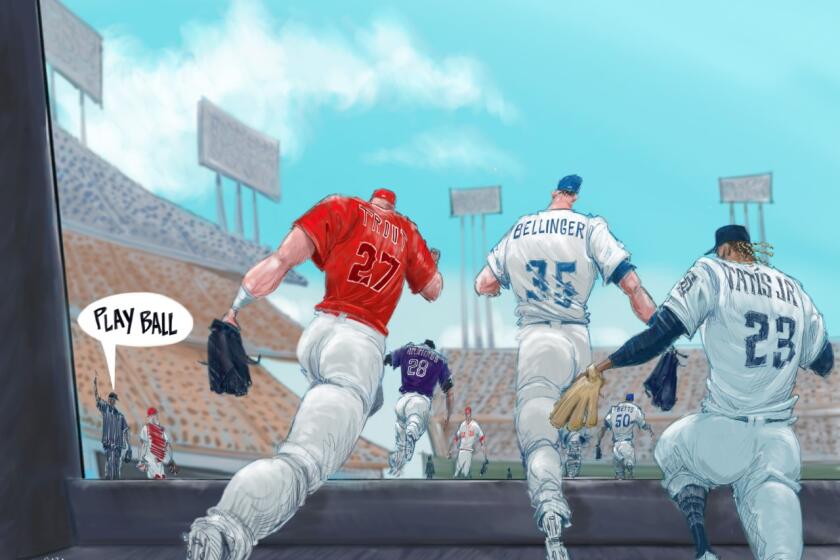Angels development plan includes 150 acres of parks, shops, homes and restaurants
- Share via
Mike Trout might or might not play in the same stadium for his whole career, but the Angels are building a whole new neighborhood around him.
The Angels unveiled the vision for their home Tuesday, with halos floating atop gateways and pathways, and beneath them 150 acres of parks, shops, homes and restaurants, with Trout and his team at the center of it all.
The Angels put off for now the decision to renovate Angel Stadium or replace it. If the Angels decide to build a new ballpark, the plan calls for it to be located immediately adjacent to the 57 Freeway, and closer to the Anaheim train station. If they renovate, they plan to open up the outfield and turn it into a grand entrance plaza.
The plan also includes two hotels, one with a view directly into the ballpark.
For Anaheim, this week brings renderings of what could be the most significant changes to the city’s landscape made by a company not named Disney.
On Wednesday, the Ducks are expected to unveil a complementary work/live/play district anchored by the Honda Center. That development, combined with the one around Angel Stadium, adds up to more than 250 acres of the urban village the city has long sought to establish in its so-called “Platinum Triangle.”
The investment by the ownership of each team includes a commitment to stay in Anaheim: the Ducks through 2048, the Angels through 2050. The Angels’ current lease allows the team to control development on the site, even by other parties, through at least 2029.
“The stadium development plan will realize the vision of the Platinum Triangle decades before the current lease allows,” Angels owner Arte Moreno said in a statement. “This plan is an important step in creating a driving economic force, while investing in Anaheim’s future.”
For fans, the plan promises gathering places for eating, drinking, shopping and relaxing before and after games, in part a bid to ease traffic that largely would be directed to two new parking structures. The plan also proposes a mix of luxury and affordable housing — a combined 5,175 residences in all — that includes such neighborhood needs as a grocery store, dry cleaners and playgrounds.
The plan also envisions 2.7-million square feet of office space and 1.1-million square feet of shops, restaurants and entertainment. The fate of the City National Grove Theater of Anaheim, located on the Katella Avenue side of the property, is undetermined under this plan.
The city agreed last December to sell the 150-acre site to Moreno’s newly formed, family-owned company for $325 million, subject to discounts for affordable housing, open space and a community benefits agreement. The final price has yet to be set.
The plan now proceeds to a city approval process; Moreno’s company has until Sept. 30 to walk away from the deal.
“This plan has the potential to bring the great experiences of baseball cities such as San Diego or Chicago to Anaheim,” Mayor Harry Sidhu said in a statement. “Not only does this proposal speak to our vision for baseball in Anaheim, the investment it represents will help move our city past the economic impacts of coronavirus in years to come.”
Construction is set to start by 2025 and run through 2050. According to Moreno’s company, the project could create 30,000 construction jobs and 45,000 permanent jobs, with the city receiving $1.2 billion in general fund revenue and $443 million in hotel taxes over 30 years. The data came from a company-commissioned report that was not made publicly available Tuesday.
Angel Stadium, which opened in 1966, is the fourth-oldest stadium in the major leagues.
The other three have been significantly enhanced in recent years, and not just within the ballparks themselves. The Boston Red Sox are working on a concert hall adjacent to Fenway Park, and they have taken over a key street outside Fenway Park on game days. The Chicago Cubs have added restaurants, a hotel and open space surrounding Wrigley Field.
The Dodgers just completed a grand plaza beyond center field, including eateries, a beer garden, sports bars, a concert plaza and a play area. Dodger Stadium opened in 1962, and Guggenheim Baseball Management has invested more than $300 million into renovations since buying the team in 2012.
The MLB season is three months late and filled with uncertainty. The surroundings will be unusual, the schedule strange, the rhythms remodeled. Let’s ‘play ball.’
Over the decades, the city has been long on glamorous development plans for the Angel Stadium property, but short on success.
After the Rams left Anaheim for St. Louis in 1995, the city pitched the NFL on buying a piece of the Angel Stadium parking lot, and building an interactive football theme park adjacent to a new NFL stadium. The NFL passed.
In 1996, the city proposed a “Sportstown” that would have included hotels, shops and offices as well as orchards, a produce market, youth sports fields and a Western village with a rodeo arena, with a plan to connect Angel Stadium to what is now Honda Center. The Walt Disney Co. bought the Angels that year, and the city asked Disney to develop the project. Disney passed, and an outside developer failed to generate interest among potential tenants.
There has been one constant through the six decades the Angels have played in Anaheim: the iconic Big A structure, now located in the stadium parking lot.
“The Big A will always be part of this property, in one version or another,” said Marie Garvey, spokeswoman for Moreno’s management company.
The rockpile Disney installed in the outfield, according to the renderings released Tuesday, will not.
More to Read
Go beyond the scoreboard
Get the latest on L.A.'s teams in the daily Sports Report newsletter.
You may occasionally receive promotional content from the Los Angeles Times.








